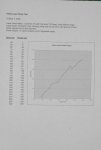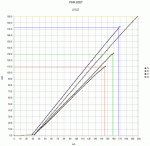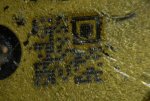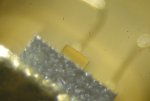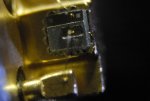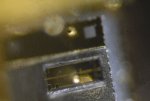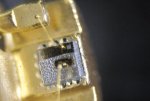billg519
0
- Joined
- Feb 21, 2008
- Messages
- 1,056
- Points
- 0
Well, this weekend I decided to finish one of my bluray projects. I had a few of the 150mw bluray diodes from ebay hanging around, so I decided to start by doing a test on one of the diodes. I set up my current regulated bench supply for 0-400ma output. The laser diode was placed in an Aixiz housing fitted with a clear acrylic lens. The rear aperture of the lens holder was opened out to the lens diameter. Power was measured using my Coherent 210 LPM with Coherent 210 Head. Current was started at 40 ma and increased in 10 ma increments up to 300 ma. This was repeated 3 times, and the average of the readings graphed as shown in the attachment below. This diode surprised me by surviving three trips up to 300 ma, including being left on and running at 300 ma for about half an hour when a phone call interrupted me during the test. After concluding this part of the test, I decided to increase current in 10 ma increments past 300 ma until diode failure occurred. Power levelled off, at 300 ma : 206 mw, 310 ma : 210 mw, 320 ma : 212 mw, 330 ma : 215 mw, 340 ma : 218 mw, 350 ma 220 mw, 360 ma : 220 mw, 370 ma = COD ! After failing, this diode still produces a small level of laser power, maybe 3 - 5 mw, but will not increase output anymore. As the Aixiz housing never became very warm, I feel that I did not overheat the diode. Since it still produces minimal output, I feel that I didn't fry the die or any bonding wires. I think that I simply overpowered the coatings on the output facet, leaving only a tiny area functional.
An interesting observation is the two "knee" areas in the graph. One occurs at the 120 to 140 ma range, power stays at 80 mw. The other area of interest was between 220 and 250 ma, where a drop in output from 170 mw to 155mw occurred before output climbed again after 250 ma.
Hopefully my wanton execution of a poor, innocent bluray laser diode will be of some use and interest to the laser experimenter community. At least I put one of these diodes into a host and fed it 190 ma, giving me a nice strong bluray to enjoy. (5th bluray ... Laser Addiction?)
Bill. (Who now owns one less bluray diode ...)
An interesting observation is the two "knee" areas in the graph. One occurs at the 120 to 140 ma range, power stays at 80 mw. The other area of interest was between 220 and 250 ma, where a drop in output from 170 mw to 155mw occurred before output climbed again after 250 ma.
Hopefully my wanton execution of a poor, innocent bluray laser diode will be of some use and interest to the laser experimenter community. At least I put one of these diodes into a host and fed it 190 ma, giving me a nice strong bluray to enjoy. (5th bluray ... Laser Addiction?)
Bill. (Who now owns one less bluray diode ...)


